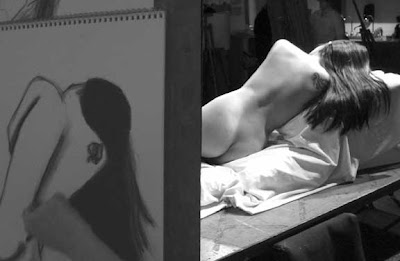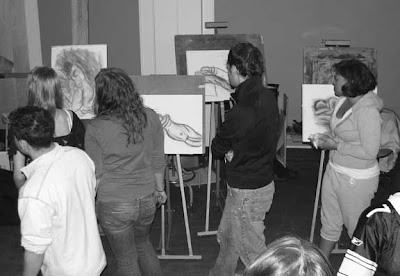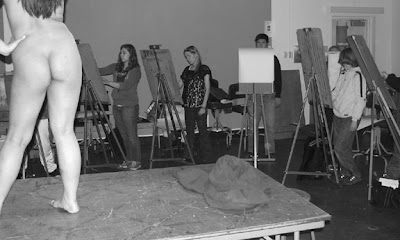
Incidentally, I have by now handed out the "checklist" of what will be expected in their portfolios, which are collected after our final critique:
PORTFOLIO CHECKLISTSeems like an awful lot of stuff in retrospect - and it is. Folks who haven't been consistent with attendance and/or output are by now hopelessly overwhelmed, and rightfully so. Students that have been caught up all along generally have little or nothing to worry about - just put it all together and call it good. As per the list, I obviously don't want every frakin' thing they've done all semester; just representative samples, the best of the bunch. This should ideally be something that they can plunk down in front of another art teacher in the department and gain admittance to a higher-level course with, or at least that's the assumption of responsibility on my end. By the time they leave my class they should be endowed with not only the perceptive and analytic skills but also adopted a serious work ethic that will serve them equally well in advanced studies, no matter what medium they choose.
Due after final critique Thursday May 8th.
A collection of work documenting your abilities & progress in this class.
All work must be clean & neat in presentation, signed & fixed
*Note any reworks.
Pick up Friday after noon - Remove all materials from room & empty drawers.
In-class Exercises:
Include your best sample(s) from these studies:
Hallways, bowling alley, symphony hall & theatre studies,
Wood Center study, boxes, fabric study, bonescape, subtractivefade-in, art department studio study, landscape gestures from slides (best three examples), xerox facial, Observation>Experience>Imagination, figure & gestures from model (minimum 5 gestures and 3 longer poses showing composition & value).
Sketchbook:
Should be full: include notes & representative sketches from:
gallery shows & pieces, greenhouse, firehouse, Fish & Game, UAF museum, random people and miscellaneous thumbnails/roughs/sketches/notes.
Assignments:
Tabletop (perspective study)
Article of Clothing (value study)
“Shrine” still-life spot illustration (wash study)
Critter spot illustrations (pen & ink/texture study)
Landscape spot illustrations
Critiques:
Interior Space
Landscape/exterior
Organic Composition
Vignette
Self-Portrait/ Caricature
* also include mandatory submission to the student art show
In this way Beginning Drawing is a prerequisite to many of the other courses in our department; in that regard I'm a de-facto gatekeeper that weeds out the weak, separating the wheat from the chaff etc.
In fact, just yesterday while at the bank someone randomly asked me if I was teaching Beginning Drawing next semester. Then they asked the two most common questions: one, can someone who doesn't know how to draw take it (well, that would be what the "beginning" part's about), and second, will it take a lot of time (in other words, an easy "A") (yes, and no). Those'd be the two biggest misconceptions in a nutshell I guess, happy to disabuse 'em both.
Meanwhile, back to figure drawing. Same drill as the day before: series of gestures leading gradually into longer poses. First with pencil on newsprint, then progress onto good drawing paper with charcoal over the initial understudy, incorporating compositional elements and pushing the value range. At certain points during the class everyone spins their easels around to face the middle of the room so we can do a quick & dirty review; compare & contrast what's working weller than others, and suggest possible improvements to the pieces. Again, this is when all of the skills and tools presented over the course of the semester should be brought to bear on these pieces.

Art tends to reflect the regional sense of place and the relationship of the community with its environment; surroundings, priorities and concerns. That's in part why the local galleries here (and for example in places like Montana) are awash with landscapes and animals. Similarly in the more urbanized areas populations become detached from such connections and develop ingrown, abstracted expressions. That's one theory at any rate.
The rejection of many traditional disciplines by Modernists (such as emphasis on figure) has somewhat influenced a Postmodernist revival in figurative work, a return to elements of classicalism. A few of my personal favorites contemporaries in this area are Paul Cadmus ("magic realism"), Lucian Freud (traditional representational), Philip Pearlstein ("figurative realism"), and don't forget Käthe Kollwitz ("naturalism").
There is some interesting philosophical divisions regarding the representation of the human figure in art history. I've studied much of the perspectives from postmodern feminist and queer theory, and they've really opened my eyes to new ways of thinking about, looking at and understanding art. Sexist depictions and the objectification of women is a common and valid criticism, one that causes cognitive dissonance in me when I use or teach with models. On the one hand, my approach is basically to distill the figure down to its simplest, underlying forms and go about drawing it in the same fashion one would analyze any other subject matter (building, plant, moose etc.), with a detached, almost clinical observation. Here at an institutional level, content is largely irrelevant to the classical, academic study of the human form. For example, while the model is posing before me, I experience immediate disassociation and a habitual disengagement so as to focus on the task at hand. To be precise, I don't really think much at all about anything, like it is driving a car (that's a scary thought, but how much do you recall the road going to work this morning?), or jogging, since figure drawing for me is mostly an exercise.
At the same time, it's virtually impossible to separate the fact that it's A) a human being B) an individual and often C) someone I personally know, with all the accompanying feelings, thoughts etc. that surround them. This plays a crucial role when drawing caricatures, when the identity of the subject informs (or deforms) the depiction in turn.
In my opinion, demographically speaking, artists tend more than most to exhibit a strong instinctual sense of empathy (the ol' "sensitive artist" stereotype), and they posses a unique ability for identification/projection that comes with the territory, and counterbalances the objectification. After all, it's like the whole 'drawing on the right side of the brain" thing - which part is telling you that? And I'll hypothesize that this empathetic relationship might account for a notable lack of such qualities and traits in the groups that have traditionally opposed creative and controversial expression. It's also the motive behind my sarcastic caveat to classes when I indoctrinate them with progressive propaganda; there's a reason it's called a College of Liberal Arts. Just kidding.
On a related tangent, the aesthetics of the idealized form versus reality is a repeating topic of discussion when drawing models, and the debate is perhaps best illustrated by the depiction of women in comics. I still don't bother read most comics books because of the overwhelming, sheer stupidity on display; rampant sexism, glorification of pointless violence etc. - not that I'm a prude by any stretch - I've just been so anesthetized as a product of my generation and years of cultural programming, that by now it all quite frankly bores the shit out of me. Same goes for the supposed standards of "beauty" and the freak show that passes for it. I find it far more interesting to observe depict everyday, normal people - as my heroine Maude would say, "they're my species."

"Modern art is what happens when painters stop looking at girls and persuade themselves that they have a better idea." - John Anthony Ciardi

Very interesting post, Jaime. Do you ever encourage your students to model for figure work? One of the most valuable things I've done to improve my figure photography and develop my empathy is to model for other photographers, and I recommend it to everyone who tells me they want to become a figure photographer. I agree that there is no escaping the objectification of the model, and anyone who thinks they can get around it is in denial, but it takes on a very different tone on the other side of the lens or easel. It's important to remember that humans aren't one dimensional, and being examined as an aesthetically appealing object in no way diminishes or negates any of the other qualities a person may possess. There's no better way to understand that than to be the object a few times.
ReplyDelete